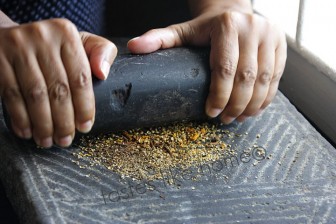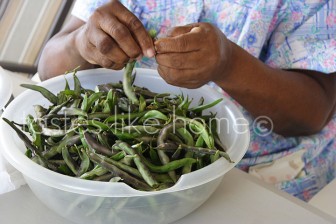Hi Everyone,
Happy New Year!
Today is the 6th birthday of this column! My, we have been chatting for a long time. I hope that the holiday season has been a good one for you, your family and loved ones.
In the first column of 2010, I had asked that we all focus on freshness, in the selection and preparation of our food. This year, I’m asking that all of us get in touch with our food; let’s connect with our food. And for all you smart-mouth ones out there who think I am giving you permission to pick up the phone and call to order food from your favourite eating establishments, that is not what I mean.
 The number one thing on many people’s top-10 lists for the New Year is to save money, and one of the ways in which they plan to do so is to cook and eat at home more often. This decision, although borne out of a need to be sensible about one’s finances in these hard economic times, is one of the first steps to connecting with our food.
The number one thing on many people’s top-10 lists for the New Year is to save money, and one of the ways in which they plan to do so is to cook and eat at home more often. This decision, although borne out of a need to be sensible about one’s finances in these hard economic times, is one of the first steps to connecting with our food.
Connecting with our food is also about connecting with those who gather around our table; it is about caring – caring about what we are putting into our bodies and those of our loved ones. At the heart of this care is what many of us are getting back to – cooking at home, selecting and handling our food with care, it’s how it used to be. It’s how it should be.
Of late we have become distant people. We don’t talk face to face anymore, read expressions, understand gestures, make eye contact etc. No, we text, we instant message, we Facebook and we Tweet – all of this done in a virtual world, at a distance. Yet we say that we are connected. In similar ways, we have distanced ourselves from our food. We claim to be eating chicken but we don’t know which part of the bird we are eating. We claim to eat fish but the generic fillet is not distinguishable. So much of our meat, seafood and poultry is processed and sold boneless, and skinless, cut up into shapes all designed to fit into trays and containers. In many cases, you can’t tell one thing from another. We don’t want to cut, mix, dice, slice or knead anything ourselves. Distance. We eat, but we don’t want to touch our food. We don’t want to get our hands “dirty”.

When it comes to cooking, you have to engage with all your senses – sight, sound, smell, taste and touch. In his book, Pig Tails and Breadfruit, Austin Clarke describes it as cooking food with feeling – tasting and touching. “Feeling-up” the food. It is how we love-up the food. Loving up the food is about showing respect to the ingredients, treating them with the care necessary so that they can reveal and give up their essence, their nutrients etc that will not only satisfy but also nourish us, mind, body and soul.
Our heavy reliance on machines in the kitchen has put our senses and hand skills out of work in such a bad way, that even whisking eggs until they are foamy requires frequent stoppage and shaking of the wrist. The use of equipment in a kitchen should be to supplement and not supplant our senses and the connection to our food.
The sense I want us to focus on this year in the kitchen, is the sense of touch. Not only is the sense of touch instructive, intuitive and informative but it is also physically good! Think about it. The act of whisking eggs, kneading dough, pounding ground provision for foo-foo, stirring cou-cou, grating coconut, grinding spices or pounding herbs to make a paste or puree works the shoulder, upper and lower arms, wrists and hands. It also increases your heart rate. However, as I’ve indicated using the sense of touch makes you a better cook.

Using the sense of touch tells you as you feel the eggplant (baigan) if it is hard instead of firm, poking the fish tells of its freshness, running your hand along meat indicates the direction of the grain, kneading dough by hand tells you of its tenderness and elasticity, gently pressing certain fruits give an indication of their stage or ripeness. Tearing the leaves of lettuce rather than cutting with a knife keeps the integrity of the leaves and prevents bruising. Caressing a tomato tells of soft spots. Bending an asparagus tells you where the tenderness begins. Feeling the firmness of an onion tells you its good. I could go on but you get the picture.
Using your hands and the sense of touch saves you money too. Buying a whole chicken and cutting it up is less expensive than buying parts. So too is buying meat at a local butcher and cutting it up yourself as opposed to buying pre-cut parts in a supermarket. Shelling and deveining the shrimp will cost less per pound than the already shelled and deveined ones. Bring home the gutted fish and clean and cut it up yourself rather than buying frozen fillets in some plastic tray. Spend a few extra minutes preparing your vegetables rather than buying them already pre-cut. Be very clear, I am not saying that you have to do this all of the time, but try to do it most of the time. Connect with your food.
When it comes to cooking there are many things that you can only judge by your sense of touch or feeling. Let me explain. The other day, a regular reader of my column that lives in the United Kingdom made the Pound Cake (Guyanese Sponge Cake) recipe from my book, Tastes Like Home. He wrote to tell me that the cake came out really well but he had a question. He noticed that I said to cream the butter and sugar with a hand mixer but noticed that when it came to mixing the batter for the cake, the directions indicated that I had switched to working with my hands using a rubber spatula. The reader wanted to know why I had made the switch and whether or not he could use a stand mixer to make the cake from creaming the butter to mixing the batter.
I answered his last question first. “Yes, you can use a stand mixer from start to finish to make the cake, what you have to be careful about, is not to over mix the cake batter as that can alter the texture of the cake once baked. As to your first question, I switched to using my hands and a rubber spatula because I am better able to “feel” the batter; working the batter with my hands this way always helps me not to over mix the batter because I can “feel” the batter as I mix it and know exactly when to stop mixing.”
The reader was a cook himself so he grasped what I meant about “feeling” the batter; it is not something that can be easily explained, it is one of those show and tell situations. I know my good friend Dave Martins would agree with the latter part of the preceding sentence as he and I have been having some back and forth conversations about kneading dough and “knowing” when it is at the right stage. The experience, knowledge or wisdom of knowing when certain things are at the right stage, temperature or tenderness comes often from frequent physical interaction with our food. If you want to cook, you have to touch, taste and smell your food.
So step into the kitchen this year and explore the food with your hands. Feel the skin beneath the onion peel and if it is leathery, remove it for it will never get tender in the pot. If the garlic is soft, get rid of it, it is stale. Knead dough, get the family involved and make your own pizzas. Grind some spices with a mortar and pestle or lorha and sil and awaken your senses. Make your own seasoning and massage the meat or chicken with your hands instead of buying it pre-seasoned. Whatever you do, get in touch with your food, make a connection, feel it up!
Happy New Year!
Cynthia





